
bumpgen
bumpgen is an AI agent that upgrades npm packages
Stars: 67
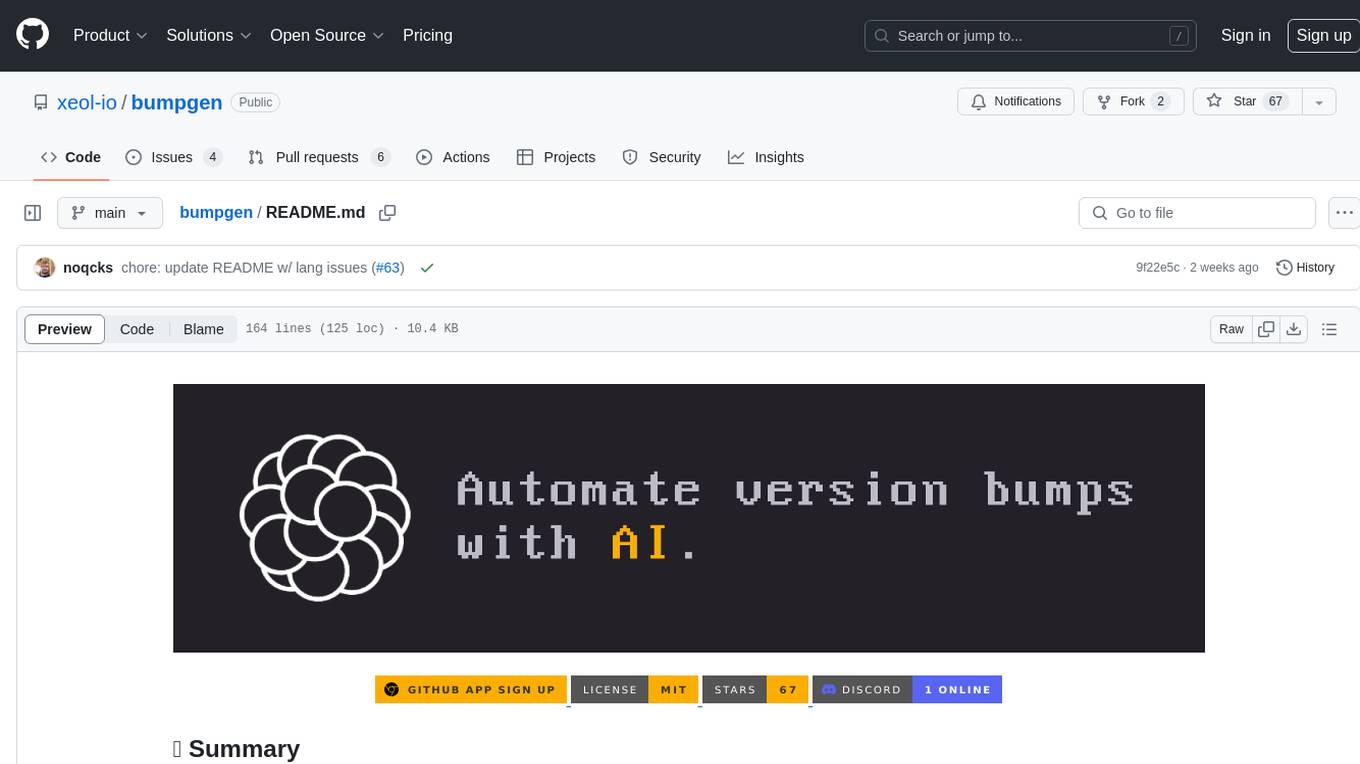
bumpgen is a tool designed to automatically upgrade TypeScript / TSX dependencies and make necessary code changes to handle any breaking issues that may arise. It uses an abstract syntax tree to analyze code relationships, type definitions for external methods, and a plan graph DAG to execute changes in the correct order. The tool is currently limited to TypeScript and TSX but plans to support other strongly typed languages in the future. It aims to simplify the process of upgrading dependencies and handling code changes caused by updates.
README:
bumpgen bumps your TypeScript / TSX dependencies and makes code changes for you if anything breaks.
Here's a common scenario:
you: "I should upgrade to the latest version of x, it has banging new features and impressive performance improvements"
you (5 minutes later): nevermind, that broke a bunch of stuff
Then use bumpgen!
How does it work?
-
bumpgenbuilds your project to understand what broke when a dependency was bumped - Then
bumpgenuses ts-morph to create an abstract syntax tree from your code, to understand the relationships between statements - It also uses the AST to get type definitions for external methods to understand how to use new package versions
-
bumpgenthen creates a plan graph DAG to execute things in the correct order to handle propagating changes (ref: arxiv 2309.12499)
[!NOTE]
bumpgenonly supports typescript and tsx at the moment, but we're working on adding support for other strongly typed languages. Hit the emoji button on our open issues for Java, golang, C# and Python to request support.
To get started, you'll need an OpenAI API key. gpt-4-turbo-preview from OpenAI is the only supported model at this time, though we plan on supporting more soon.
Then, run bumpgen:
> export LLM_API_KEY="<openai-api-key>"
> cd ~/my-repository
> npm install -g bumpgen
> bumpgen @tanstack/react-query 5.28.14
where @tanstack/react-query is the package you want to bump and 5.28.14 is the version you want to bump to.
You can also run bumpgen without arguments and select which package to upgrade from the menu. Use bumpgen --help for a complete list of options.
[!NOTE] If you'd like to be first in line to try the
bumpgenGitHub App to replace your usage of dependabot + renovatebot, sign up here.
There are some limitations you should know about.
-
bumpgenrelies on build errors to determine what needs to be fixed. If an issue is caused by a behavioral change,bumpgenwon't detect it. -
bumpgencan't handle multiple packages at the same time. It will fail to upgrade packages that require peer dependencies to be updated the same time to work such as@octokit/coreand@octokit/plugin-retry. -
bumpgenis not good with very large frameworks likevue. These kind of upgrades (and vue 2 -> 3 specifically) can be arduous even for a human.
> bumpgen @tanstack/react-query 5.28.14
│
┌┬─────▼──────────────────────────────────────────────────────────────────────┐
││ CLI │
└┴─────┬──▲───────────────────────────────────────────────────────────────────┘
│ │
┌┬─────▼──┴───────────────────────────────────────────────────────────────────┐
││ Core (Codeplan) │
││ │
││ ┌───────────────────────────────────┐ ┌──────────────────────────────────┐ │
││ │ Plan Graph │ │ Abstract Syntax Tree │ │
││ │ │ │ │ │
││ │ │ │ │ │
││ │ ┌─┐ │ │ ┌─┐ │ │
││ │ ┌──┴─┘ │ │ ┌──┴─┴──┐ │ │
││ │ │ │ │ │ │ │ │
││ │ ┌▼┐ ┌──┼─┼──┐ ┌▼┐ ┌▼┐ │ │
││ │ └─┴──┐ │ │ │ │ ┌──┴─┴──┐ └─┘ │ │
││ │ │ │ │ ▼ │ │ │ │
││ │ ┌▼┐ ▲ │ │ ┌▼┐ ┌▼┐ │ │
││ │ └─┴──┐ │ │ │ │ └─┘ ┌──┴─┴──┐ │ │
││ │ │ └──┼─┼──┘ │ │ │ │
││ │ ┌▼┐ │ │ ┌▼┐ ┌▼┐ │ │
││ │ └─┘ │ │ └─┘ └─┘ │ │
││ │ │ │ │ │
││ │ │ │ │ │
││ │ │ │ │ │
││ │ │ │ │ │
││ └───────────────────────────────────┘ └──────────────────────────────────┘ │
││ │
└┴─────┬──▲───────────────────────────────────────────────────────────────────┘
│ │
┌┬─────▼──┴───────────────────────────┐ ┌┬───────────────────────────────────┐
││ Prompt Context │ ││ LLM │
││ │ ││ │
││ - plan graph │ ││ GPT4-Turbo, Claude 3, BYOM │
││ - errors ├──►│ │
││ - code │ ││ │
││ ◄──┼│ │
││ │ ││ │
││ │ ││ │
││ │ ││ │
└┴────────────────────────────────────┘ └┴───────────────────────────────────┘
The AST is generated from ts-morph. This AST allows bumpgen to understand the relationship between nodes in a codebase.
The plan graph is a concept detailed in codeplan by Microsoft. The plan graph allows bumpgen to not only fix an issue at a point but also fix the 2nd order breaking changes from the fix itself. In short, it allows bumpgen to propagate a fix to the rest of the codebase.
We pass the plan graph, the error, and the actual file with the breaking change as context to the LLM to maximize its ability to fix the issue.
We only support gpt-4-turbo-preview at this time.
bumpgen + GPT-4 Turbo ██████████░░░░░░░░░░░ 45% (67 tasks)
We benchmarked bumpgen with GPT-4 Turbo against a suite of version bumps with breaking changes. You can check out the evals here.
Contributions are welcome! To get set up for development, see Development.
- [x] codeplan
- [x] Typescript/TSX support
- [ ]
bumpgenGitHub app - [ ] Embeddings for different package versions
- [ ] Use test runners as an oracle
- [ ] C# support
- [ ] Java support
- [ ] Go support
Join our Discord community to contribute, learn more, and ask questions!
For Tasks:
Click tags to check more tools for each tasksFor Jobs:
Alternative AI tools for bumpgen
Similar Open Source Tools

bumpgen
bumpgen is a tool designed to automatically upgrade TypeScript / TSX dependencies and make necessary code changes to handle any breaking issues that may arise. It uses an abstract syntax tree to analyze code relationships, type definitions for external methods, and a plan graph DAG to execute changes in the correct order. The tool is currently limited to TypeScript and TSX but plans to support other strongly typed languages in the future. It aims to simplify the process of upgrading dependencies and handling code changes caused by updates.
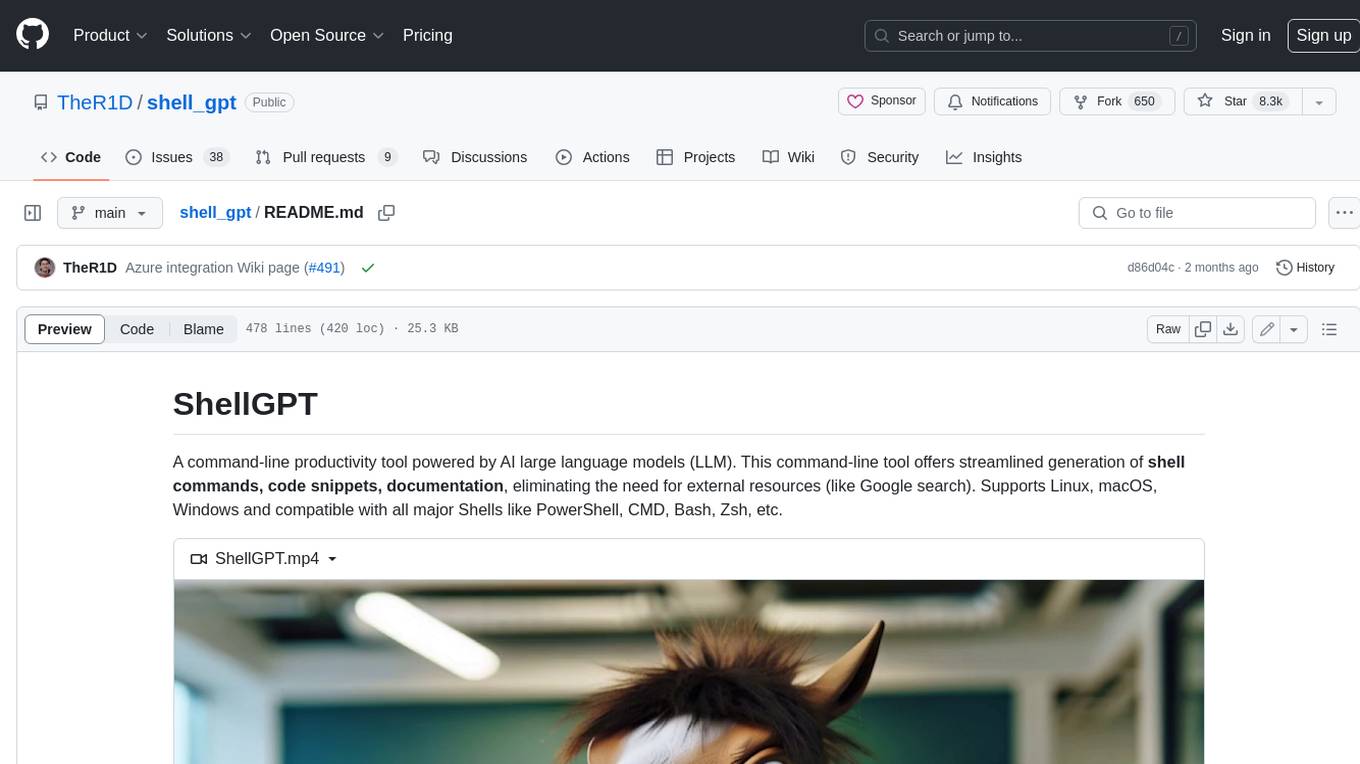
shell_gpt
ShellGPT is a command-line productivity tool powered by AI large language models (LLMs). This command-line tool offers streamlined generation of shell commands, code snippets, documentation, eliminating the need for external resources (like Google search). Supports Linux, macOS, Windows and compatible with all major Shells like PowerShell, CMD, Bash, Zsh, etc.
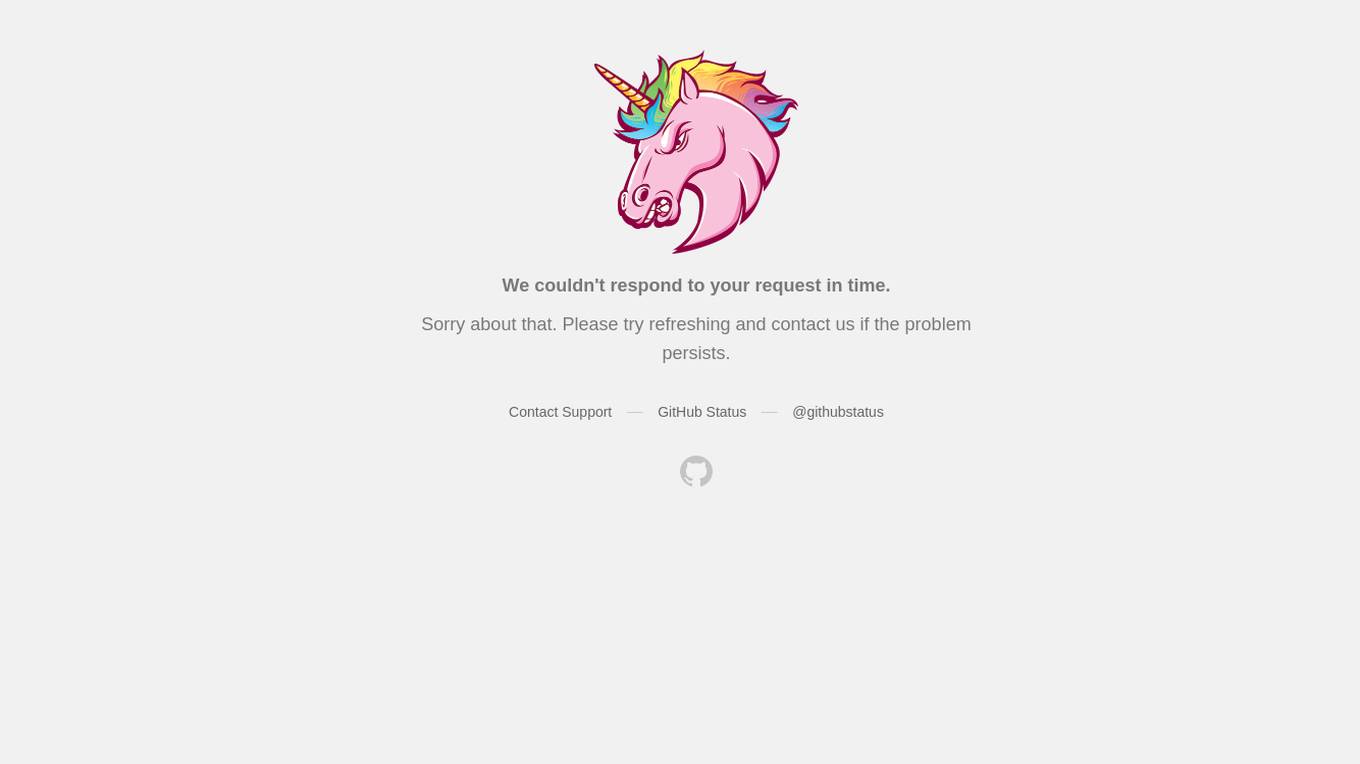
gpt-all-star
GPT-All-Star is an AI-powered code generation tool designed for scratch development of web applications with team collaboration of autonomous AI agents. The primary focus of this research project is to explore the potential of autonomous AI agents in software development. Users can organize their team, choose leaders for each step, create action plans, and work together to complete tasks. The tool supports various endpoints like OpenAI, Azure, and Anthropic, and provides functionalities for project management, code generation, and team collaboration.
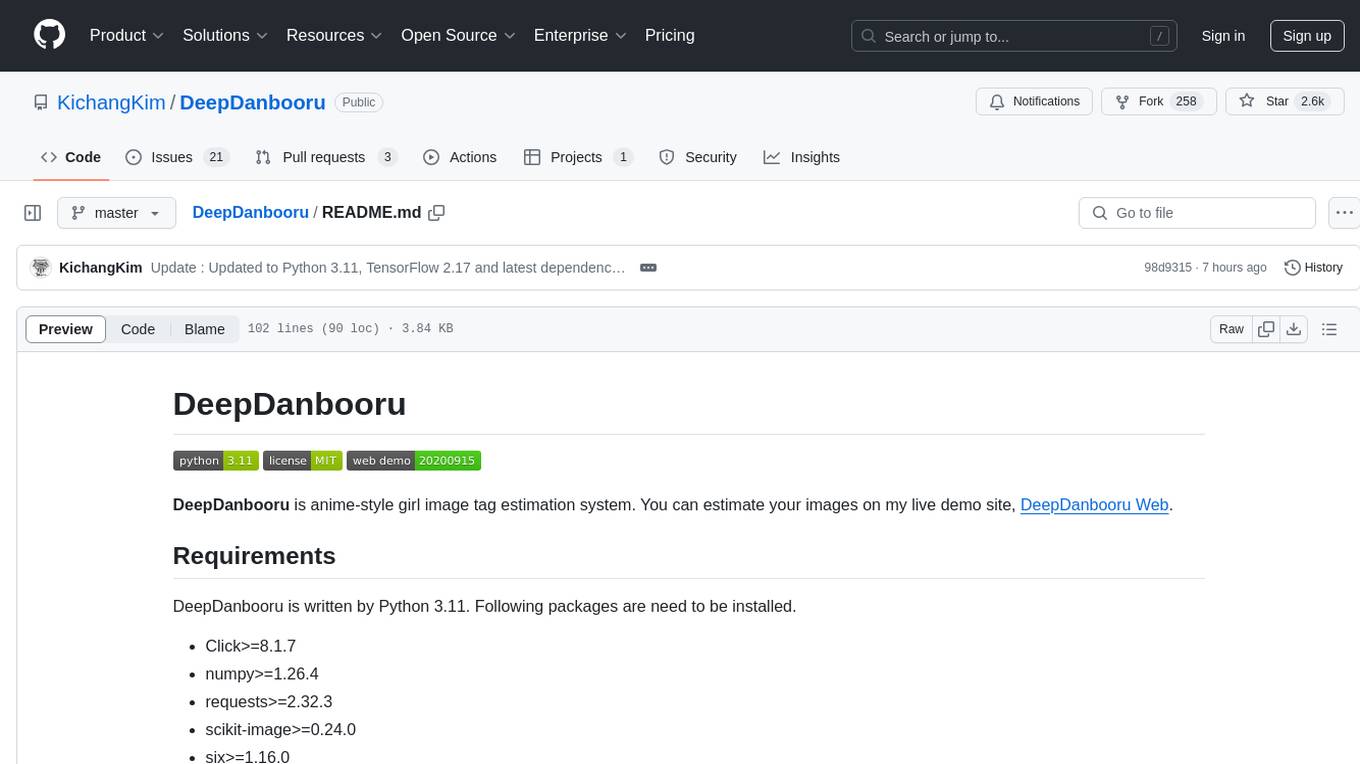
DeepDanbooru
DeepDanbooru is an anime-style girl image tag estimation system written in Python. It allows users to estimate images using a live demo site. The tool requires specific packages to be installed and provides a structured dataset for training projects. Users can create training projects, download tags, filter datasets, and start training to estimate tags for images. The tool uses a specific dataset structure and project structure to facilitate the training process.
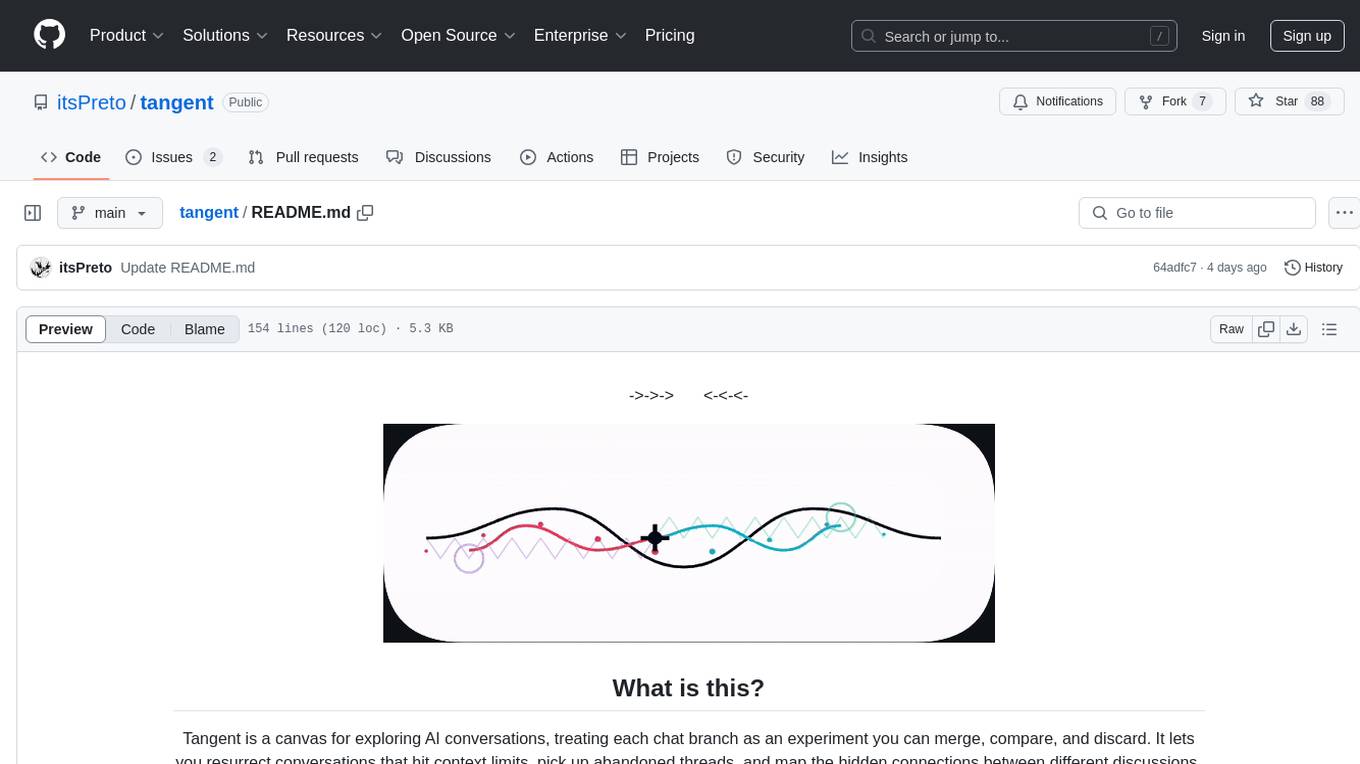
tangent
Tangent is a canvas for exploring AI conversations, allowing users to resurrect and continue conversations, branch and explore different ideas, organize conversations by topics, and support archive data exports. It aims to provide a visual/textual/audio exploration experience with AI assistants, offering a 'thoughts workbench' for experimenting freely, reviving old threads, and diving into tangents. The project structure includes a modular backend with components for API routes, background task management, data processing, and more. Prerequisites for setup include Whisper.cpp, Ollama, and exported archive data from Claude or ChatGPT. Users can initialize the environment, install Python packages, set up Ollama, configure local models, and start the backend and frontend to interact with the tool.
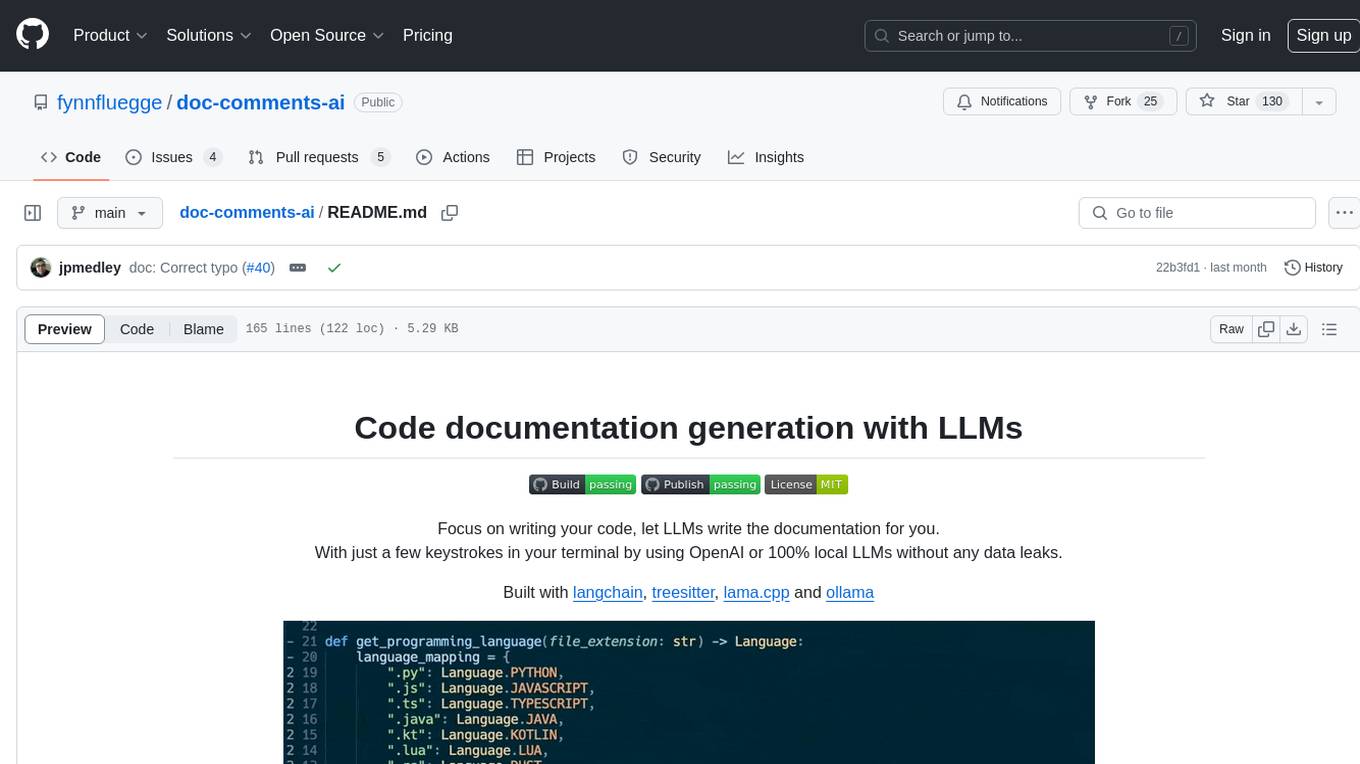
doc-comments-ai
doc-comments-ai is a tool designed to automatically generate code documentation using language models. It allows users to easily create documentation comment blocks for methods in various programming languages such as Python, Typescript, Javascript, Java, Rust, and more. The tool supports both OpenAI and local LLMs, ensuring data privacy and security. Users can generate documentation comments for methods in files, inline comments in method bodies, and choose from different models like GPT-3.5-Turbo, GPT-4, and Azure OpenAI. Additionally, the tool provides support for Treesitter integration and offers guidance on selecting the appropriate model for comprehensive documentation needs.
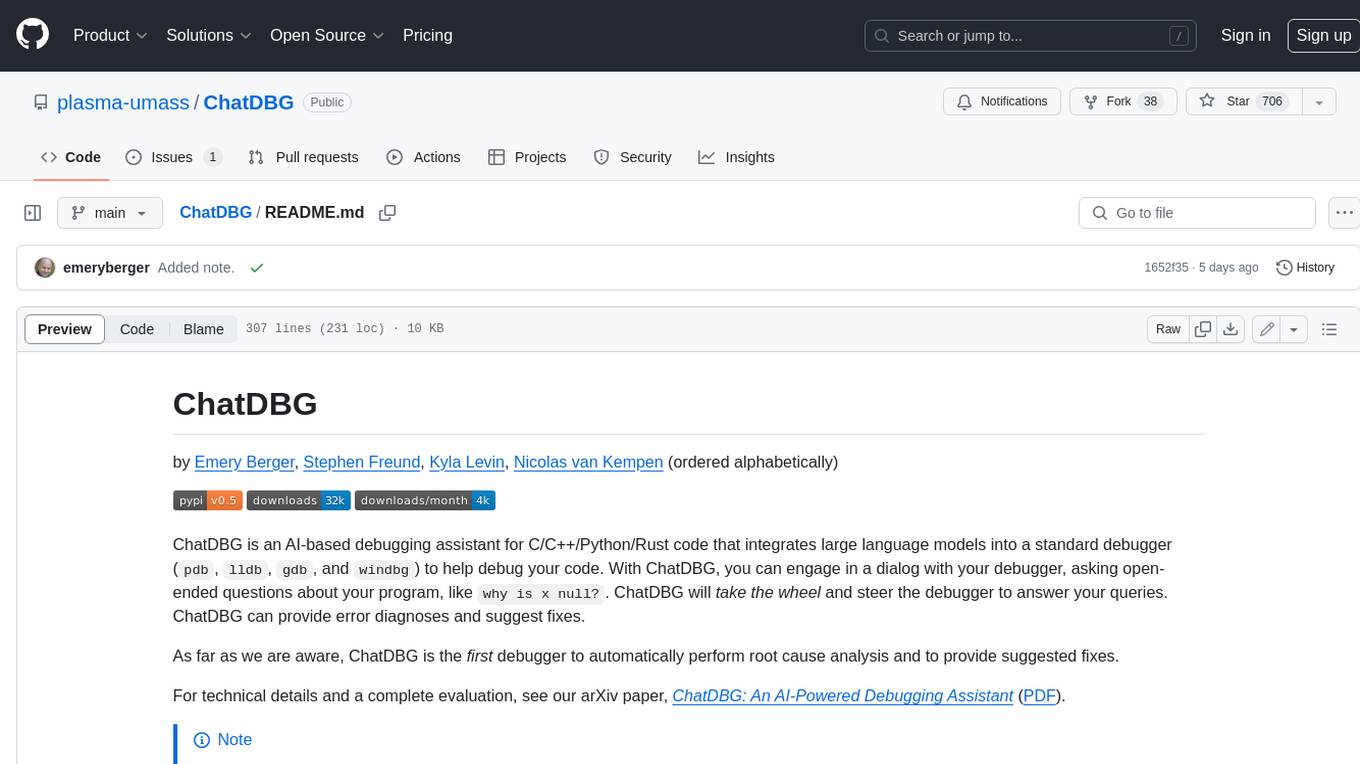
ChatDBG
ChatDBG is an AI-based debugging assistant for C/C++/Python/Rust code that integrates large language models into a standard debugger (`pdb`, `lldb`, `gdb`, and `windbg`) to help debug your code. With ChatDBG, you can engage in a dialog with your debugger, asking open-ended questions about your program, like `why is x null?`. ChatDBG will _take the wheel_ and steer the debugger to answer your queries. ChatDBG can provide error diagnoses and suggest fixes. As far as we are aware, ChatDBG is the _first_ debugger to automatically perform root cause analysis and to provide suggested fixes.
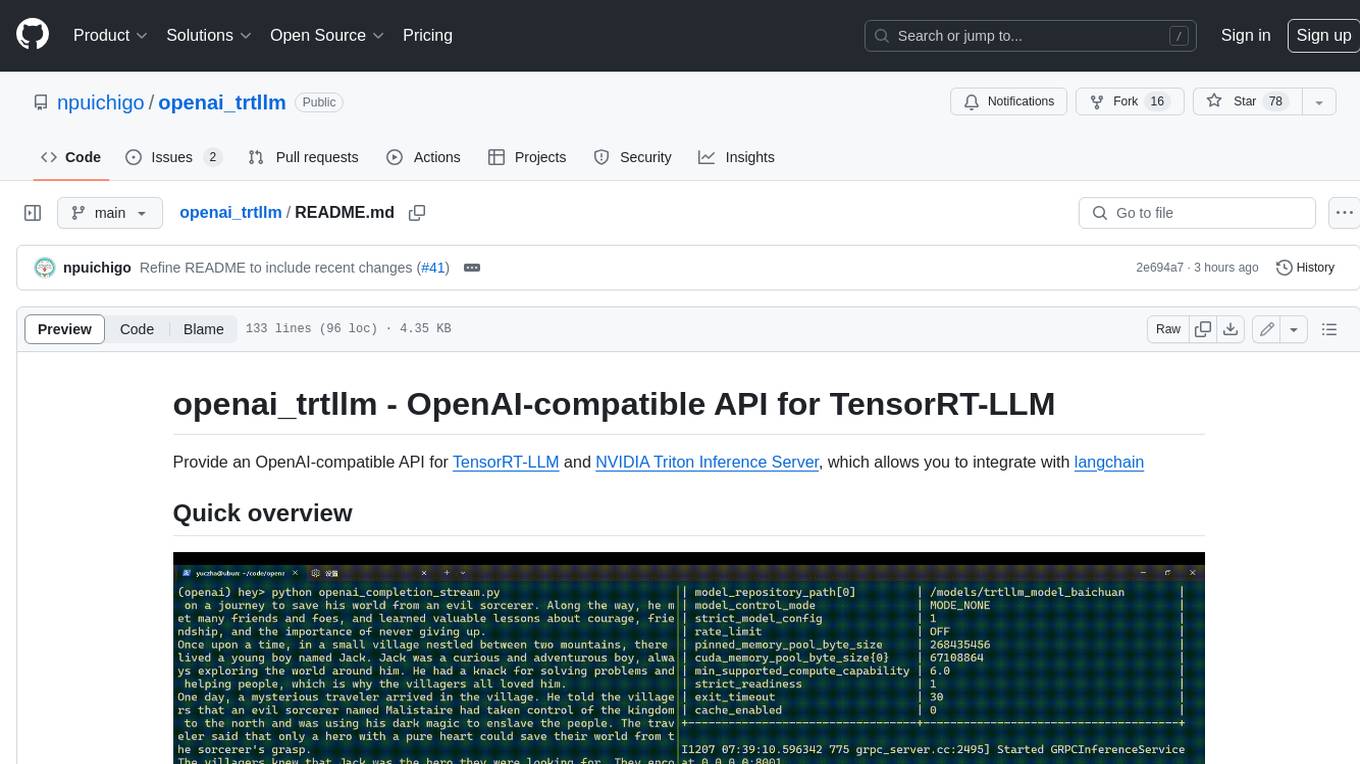
openai_trtllm
OpenAI-compatible API for TensorRT-LLM and NVIDIA Triton Inference Server, which allows you to integrate with langchain
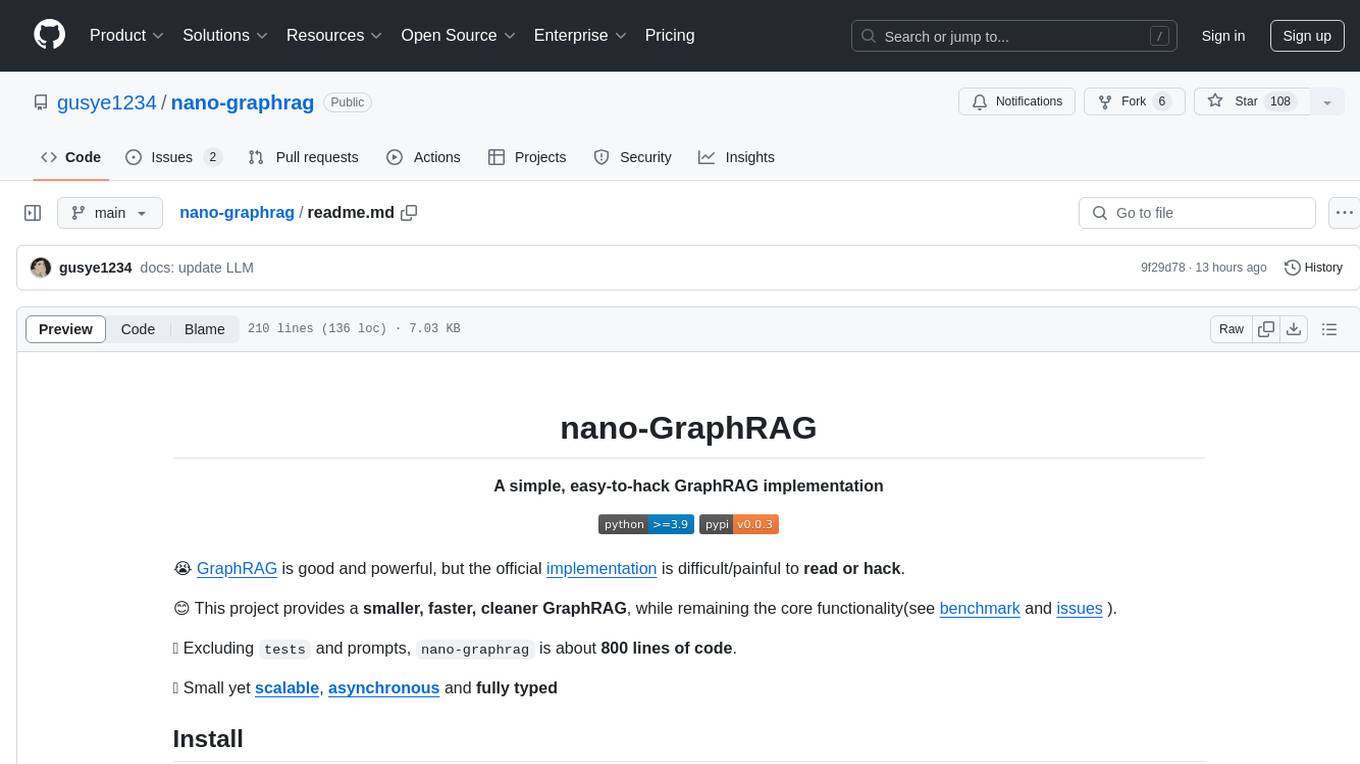
nano-graphrag
nano-GraphRAG is a simple, easy-to-hack implementation of GraphRAG that provides a smaller, faster, and cleaner version of the official implementation. It is about 800 lines of code, small yet scalable, asynchronous, and fully typed. The tool supports incremental insert, async methods, and various parameters for customization. Users can replace storage components and LLM functions as needed. It also allows for embedding function replacement and comes with pre-defined prompts for entity extraction and community reports. However, some features like covariates and global search implementation differ from the original GraphRAG. Future versions aim to address issues related to data source ID, community description truncation, and add new components.
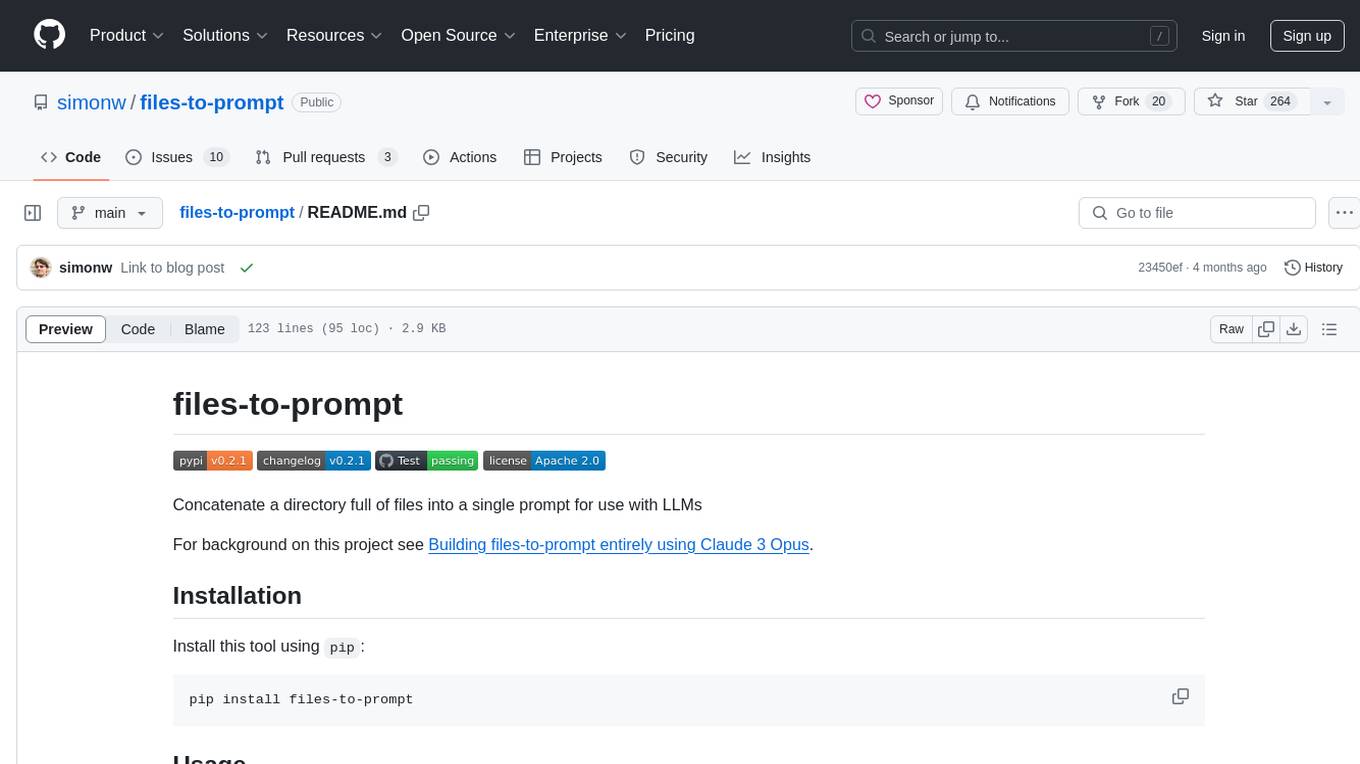
files-to-prompt
files-to-prompt is a tool that concatenates a directory full of files into a single prompt for use with Language Models (LLMs). It allows users to provide the path to one or more files or directories for processing, outputting the contents of each file with relative paths and separators. The tool offers options to include hidden files, ignore specific patterns, and exclude files specified in .gitignore. It is designed to streamline the process of preparing text data for LLMs by simplifying file concatenation and customization.
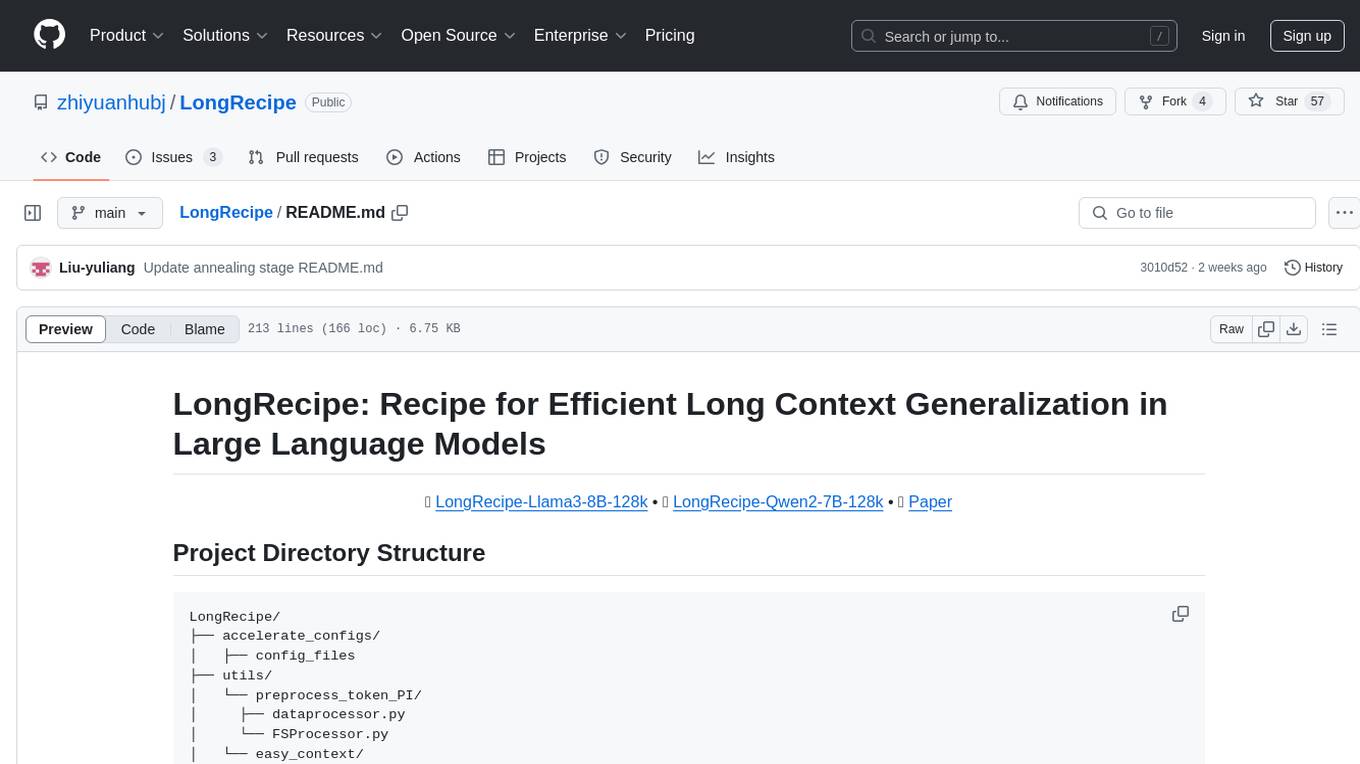
LongRecipe
LongRecipe is a tool designed for efficient long context generalization in large language models. It provides a recipe for extending the context window of language models while maintaining their original capabilities. The tool includes data preprocessing steps, model training stages, and a process for merging fine-tuned models to enhance foundational capabilities. Users can follow the provided commands and scripts to preprocess data, train models in multiple stages, and merge models effectively.
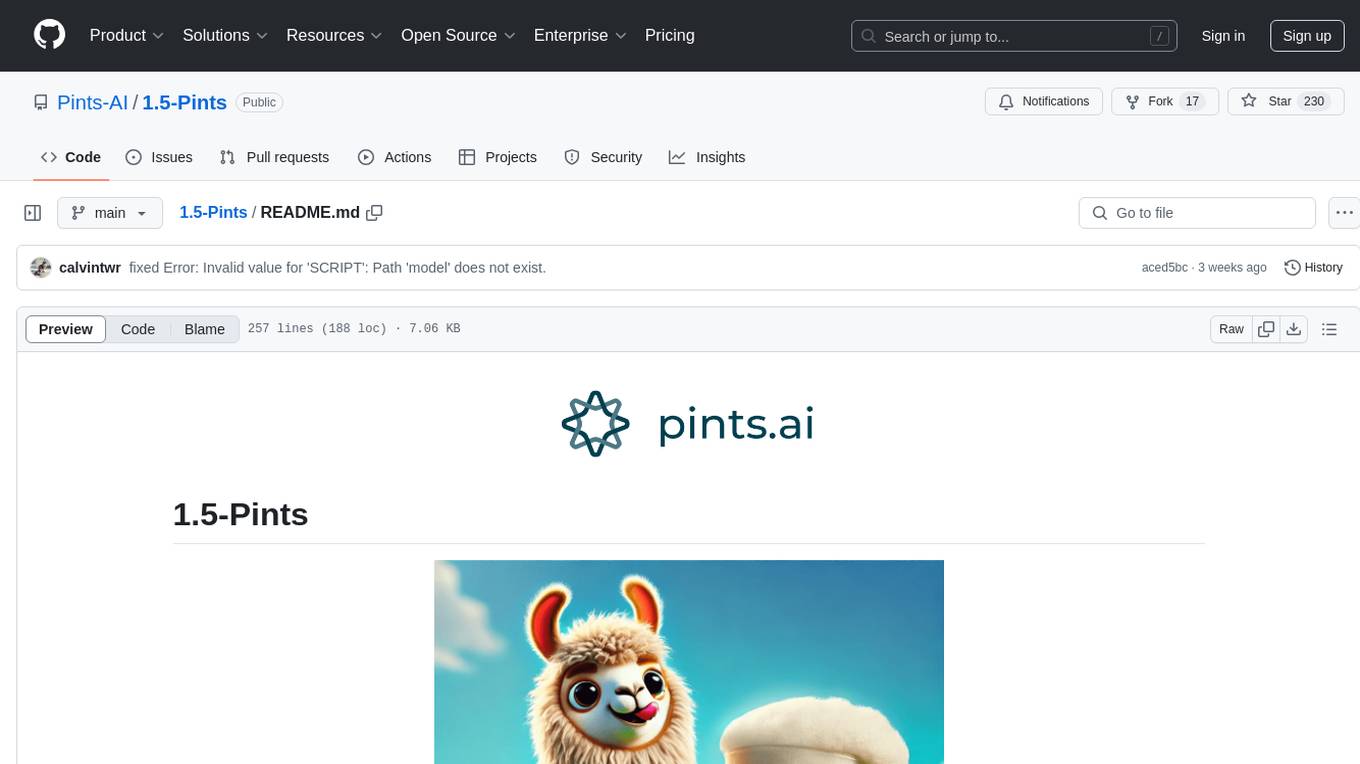
1.5-Pints
1.5-Pints is a repository that provides a recipe to pre-train models in 9 days, aiming to create AI assistants comparable to Apple OpenELM and Microsoft Phi. It includes model architecture, training scripts, and utilities for 1.5-Pints and 0.12-Pint developed by Pints.AI. The initiative encourages replication, experimentation, and open-source development of Pint by sharing the model's codebase and architecture. The repository offers installation instructions, dataset preparation scripts, model training guidelines, and tools for model evaluation and usage. Users can also find information on finetuning models, converting lit models to HuggingFace models, and running Direct Preference Optimization (DPO) post-finetuning. Additionally, the repository includes tests to ensure code modifications do not disrupt the existing functionality.
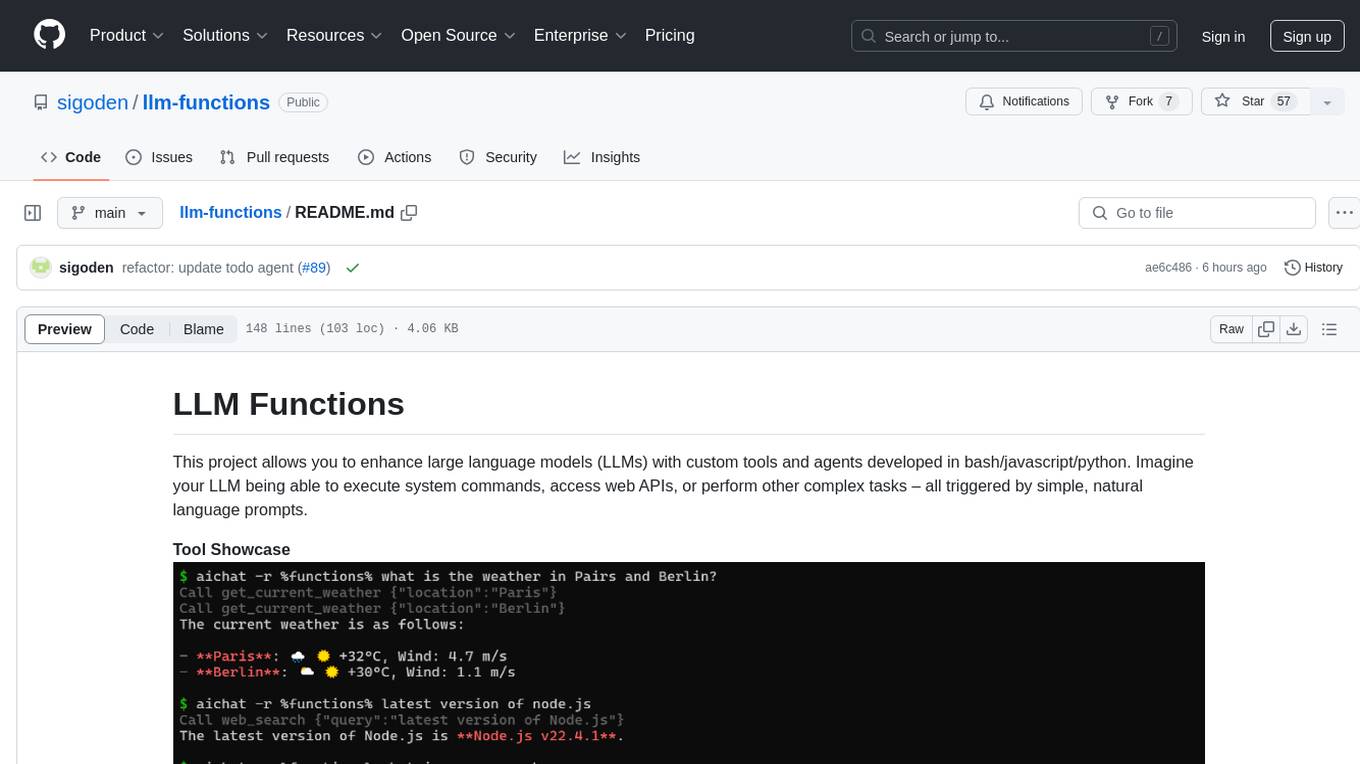
llm-functions
LLM Functions is a project that enables the enhancement of large language models (LLMs) with custom tools and agents developed in bash, javascript, and python. Users can create tools for their LLM to execute system commands, access web APIs, or perform other complex tasks triggered by natural language prompts. The project provides a framework for building tools and agents, with tools being functions written in the user's preferred language and automatically generating JSON declarations based on comments. Agents combine prompts, function callings, and knowledge (RAG) to create conversational AI agents. The project is designed to be user-friendly and allows users to easily extend the capabilities of their language models.
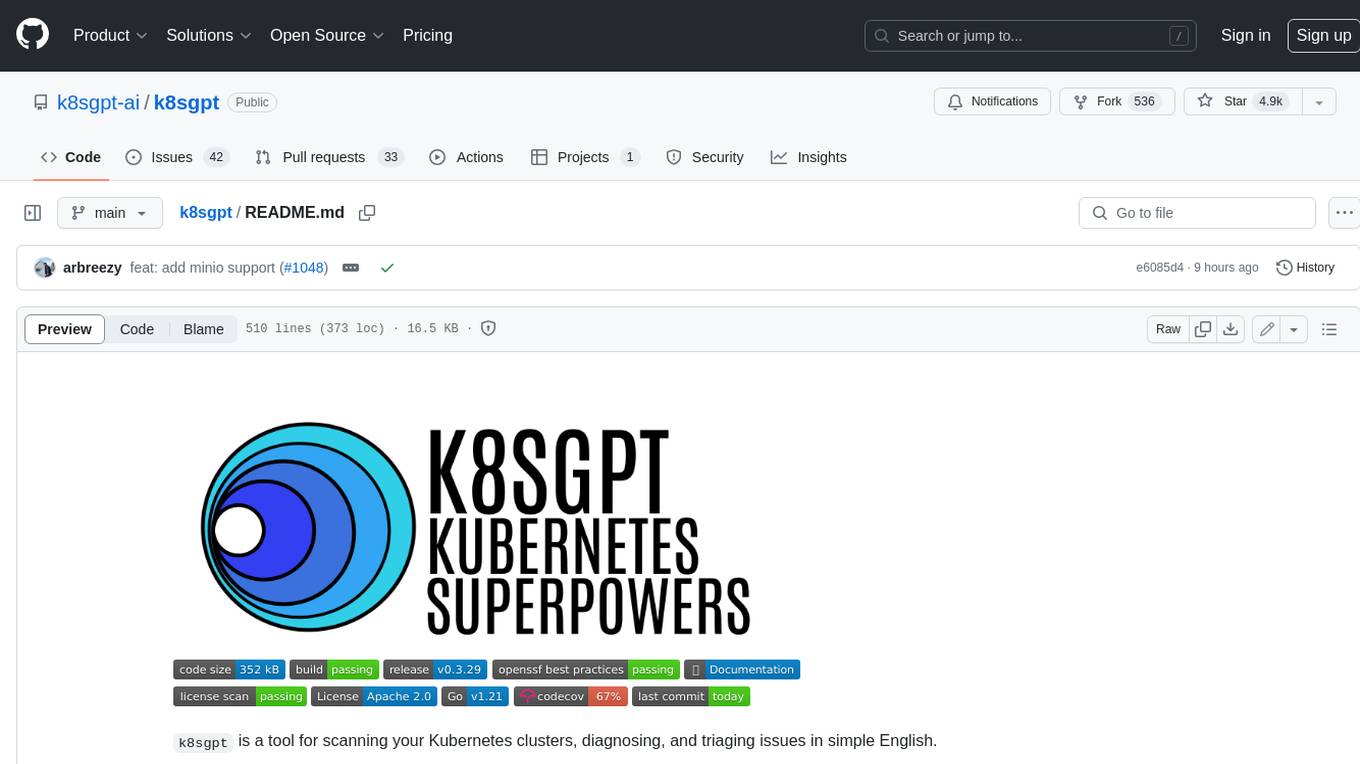
k8sgpt
K8sGPT is a tool for scanning your Kubernetes clusters, diagnosing, and triaging issues in simple English. It has SRE experience codified into its analyzers and helps to pull out the most relevant information to enrich it with AI.
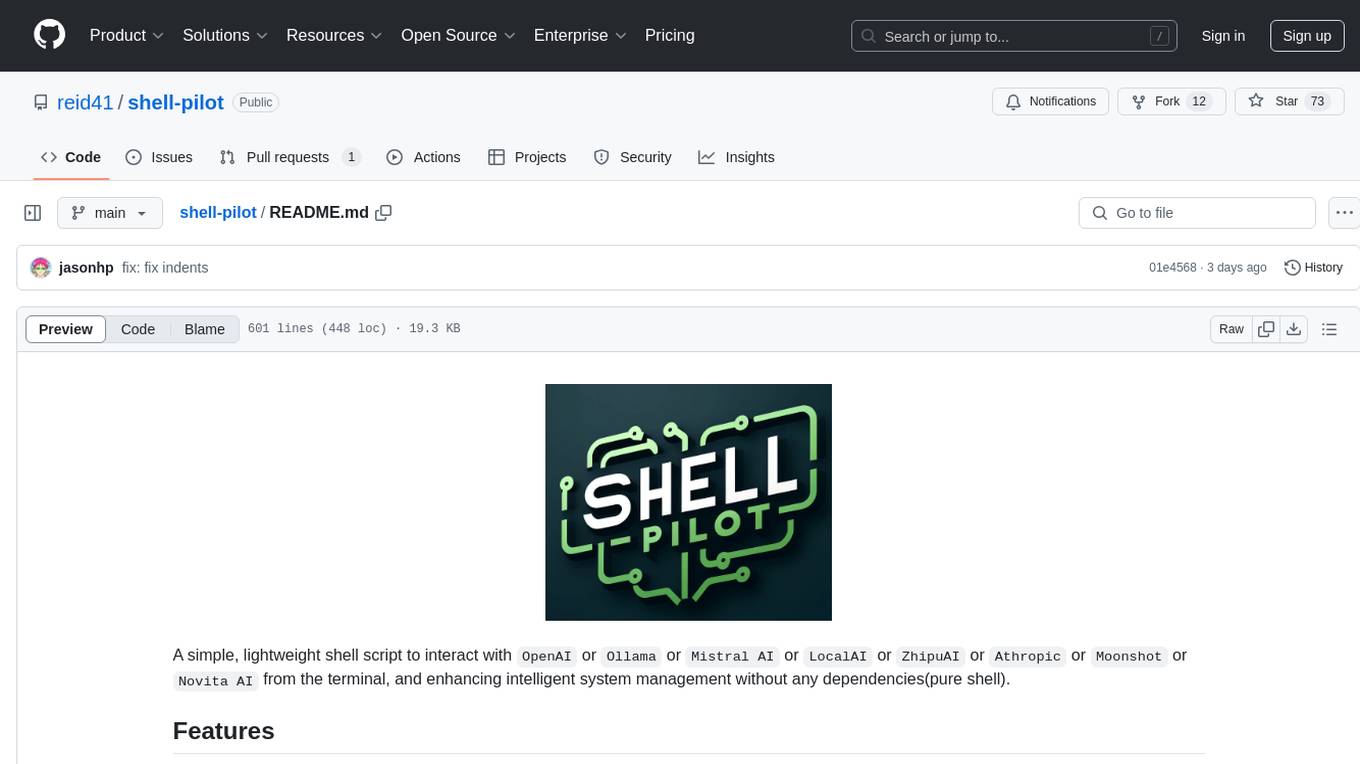
shell-pilot
Shell-pilot is a simple, lightweight shell script designed to interact with various AI models such as OpenAI, Ollama, Mistral AI, LocalAI, ZhipuAI, Anthropic, Moonshot, and Novita AI from the terminal. It enhances intelligent system management without any dependencies, offering features like setting up a local LLM repository, using official models and APIs, viewing history and session persistence, passing input prompts with pipe/redirector, listing available models, setting request parameters, generating and running commands in the terminal, easy configuration setup, system package version checking, and managing system aliases.
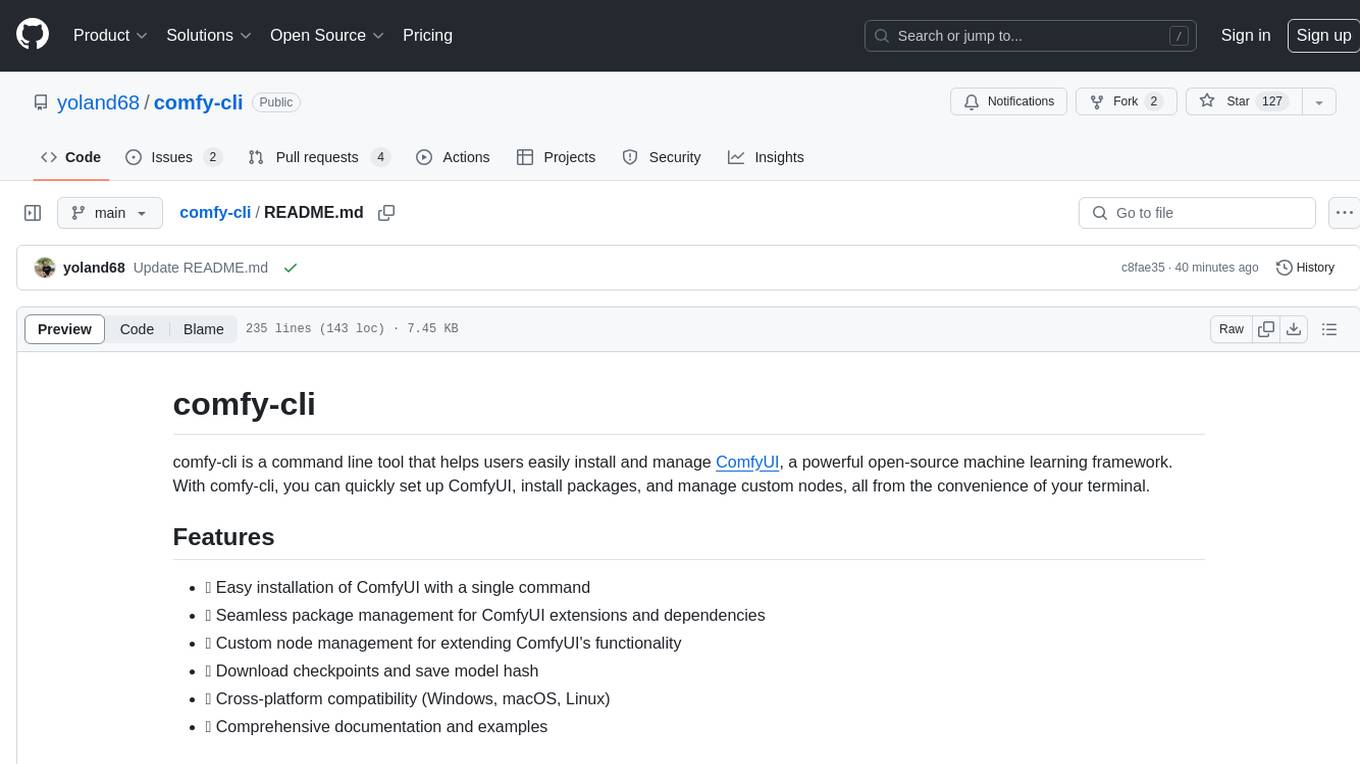
comfy-cli
comfy-cli is a command line tool designed to simplify the installation and management of ComfyUI, an open-source machine learning framework. It allows users to easily set up ComfyUI, install packages, manage custom nodes, download checkpoints, and ensure cross-platform compatibility. The tool provides comprehensive documentation and examples to aid users in utilizing ComfyUI efficiently.
For similar tasks

bumpgen
bumpgen is a tool designed to automatically upgrade TypeScript / TSX dependencies and make necessary code changes to handle any breaking issues that may arise. It uses an abstract syntax tree to analyze code relationships, type definitions for external methods, and a plan graph DAG to execute changes in the correct order. The tool is currently limited to TypeScript and TSX but plans to support other strongly typed languages in the future. It aims to simplify the process of upgrading dependencies and handling code changes caused by updates.
For similar jobs

kaito
Kaito is an operator that automates the AI/ML inference model deployment in a Kubernetes cluster. It manages large model files using container images, avoids tuning deployment parameters to fit GPU hardware by providing preset configurations, auto-provisions GPU nodes based on model requirements, and hosts large model images in the public Microsoft Container Registry (MCR) if the license allows. Using Kaito, the workflow of onboarding large AI inference models in Kubernetes is largely simplified.

ai-on-gke
This repository contains assets related to AI/ML workloads on Google Kubernetes Engine (GKE). Run optimized AI/ML workloads with Google Kubernetes Engine (GKE) platform orchestration capabilities. A robust AI/ML platform considers the following layers: Infrastructure orchestration that support GPUs and TPUs for training and serving workloads at scale Flexible integration with distributed computing and data processing frameworks Support for multiple teams on the same infrastructure to maximize utilization of resources

tidb
TiDB is an open-source distributed SQL database that supports Hybrid Transactional and Analytical Processing (HTAP) workloads. It is MySQL compatible and features horizontal scalability, strong consistency, and high availability.
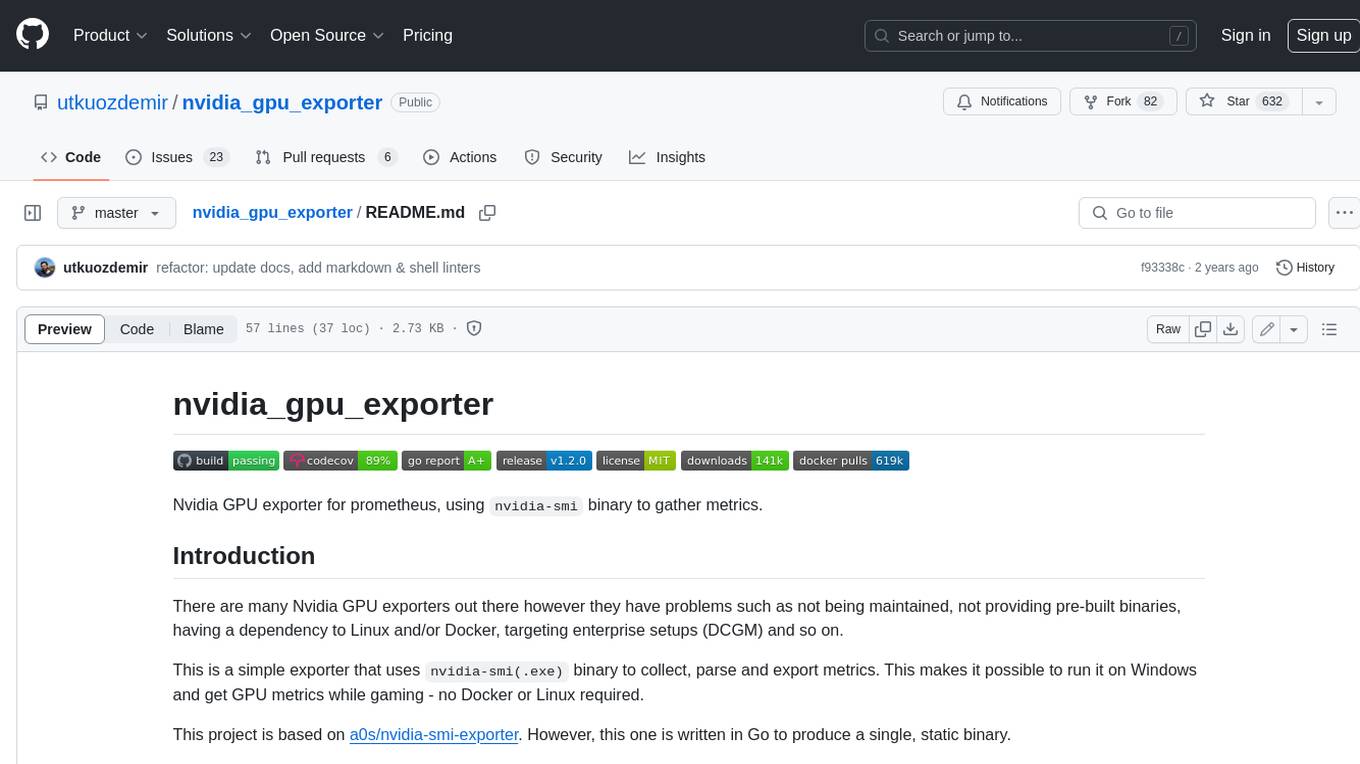
nvidia_gpu_exporter
Nvidia GPU exporter for prometheus, using `nvidia-smi` binary to gather metrics.
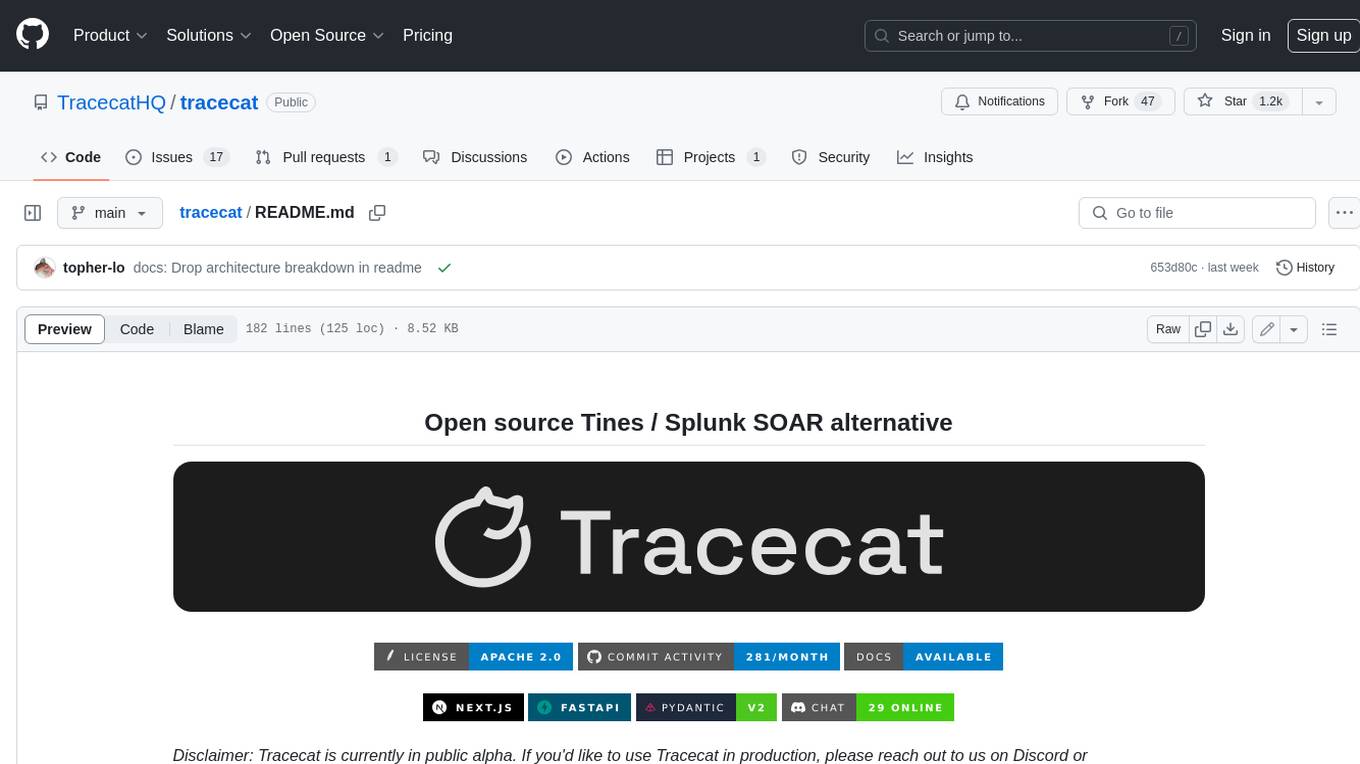
tracecat
Tracecat is an open-source automation platform for security teams. It's designed to be simple but powerful, with a focus on AI features and a practitioner-obsessed UI/UX. Tracecat can be used to automate a variety of tasks, including phishing email investigation, evidence collection, and remediation plan generation.
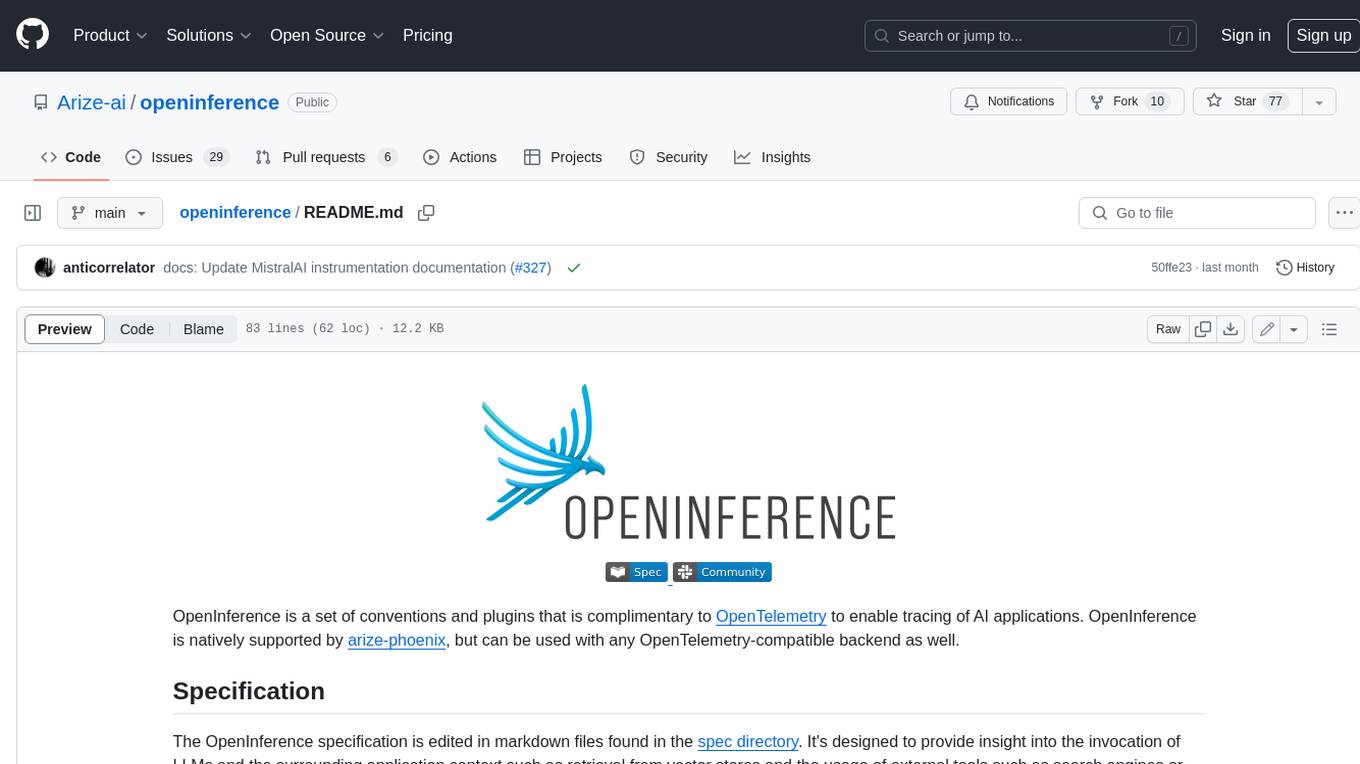
openinference
OpenInference is a set of conventions and plugins that complement OpenTelemetry to enable tracing of AI applications. It provides a way to capture and analyze the performance and behavior of AI models, including their interactions with other components of the application. OpenInference is designed to be language-agnostic and can be used with any OpenTelemetry-compatible backend. It includes a set of instrumentations for popular machine learning SDKs and frameworks, making it easy to add tracing to your AI applications.

BricksLLM
BricksLLM is a cloud native AI gateway written in Go. Currently, it provides native support for OpenAI, Anthropic, Azure OpenAI and vLLM. BricksLLM aims to provide enterprise level infrastructure that can power any LLM production use cases. Here are some use cases for BricksLLM: * Set LLM usage limits for users on different pricing tiers * Track LLM usage on a per user and per organization basis * Block or redact requests containing PIIs * Improve LLM reliability with failovers, retries and caching * Distribute API keys with rate limits and cost limits for internal development/production use cases * Distribute API keys with rate limits and cost limits for students
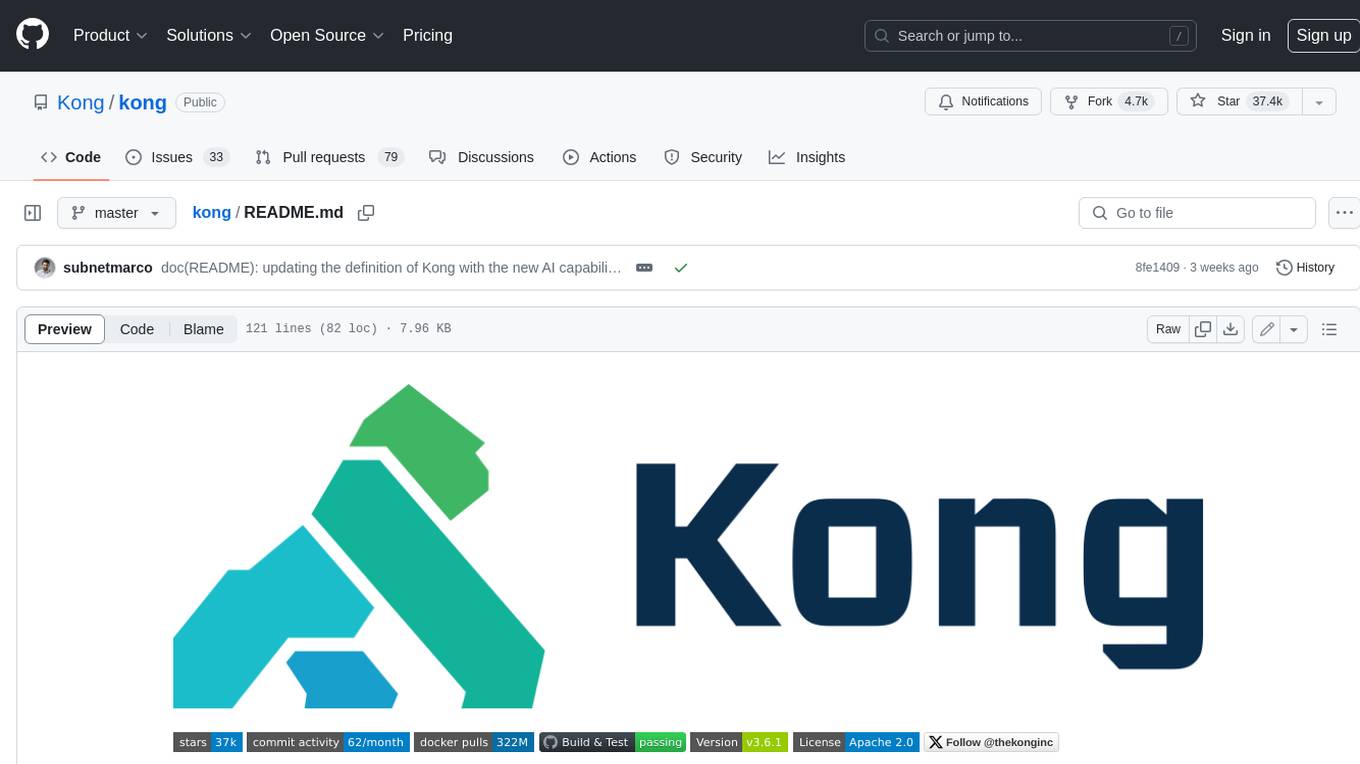
kong
Kong, or Kong API Gateway, is a cloud-native, platform-agnostic, scalable API Gateway distinguished for its high performance and extensibility via plugins. It also provides advanced AI capabilities with multi-LLM support. By providing functionality for proxying, routing, load balancing, health checking, authentication (and more), Kong serves as the central layer for orchestrating microservices or conventional API traffic with ease. Kong runs natively on Kubernetes thanks to its official Kubernetes Ingress Controller.




.gif)
